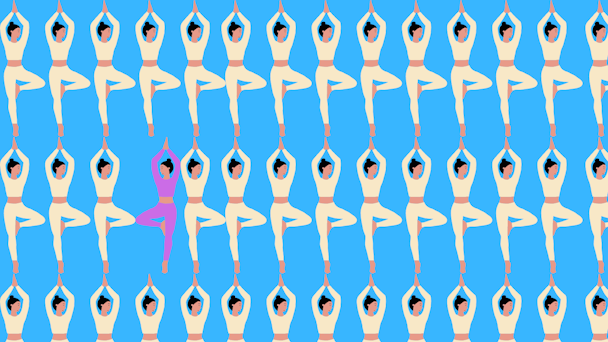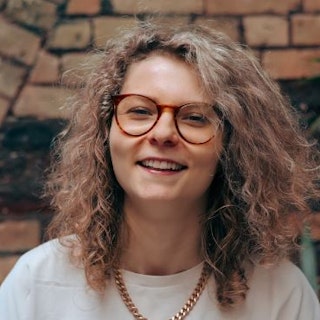I know why you can’t remember the name of that viral TikTok brand
Pollyanna Ward’s back after mulling over common TikTok marketing tactics. By following them, you may be falling into a trap.

I’ve bought at least 26 things in the past three years due to a TikTok video.
Magnetic clouds hold my keys, I carry a travel pilates bar, and my two-tier dish rack is indispensable. These are just some things I was compelled to buy after Cool-People-Who-Have-Their-Lives-Together said they were ✨essential✨.
But do I remember any of the brands that made these products? Nope.
You might be thinking, ‘So what?’ but as someone who enjoys helping brands grow, this is one of the last things you want to hear from your customers. Here’s why brands need to become more memorable.
Why is this happening?
In 2020, TikTok launched its campaign ‘Don’t Make Ads, Make TikToks’ to encourage brands to consider their platform for advertising as a break away from traditional channels. It was a masterclass in B2B marketing: TikTok reps were armed with reams of data showing how the native TikTok style engaged audiences more. It had toolkits showing how to make ‘TikToks, Not Ads.’ This was coupled with entertaining videos of TikTokers to promote the platform, a content series in partnership with leading trade publications, and one of the catchiest slogans that I still hear used today. It positioned TikTok as the fun, playful cousin to your boring, formulaic and functional ads that have done a job for decades.
Advertisement
Luckily for TikTok, it appeared to work. It defied all the other platform forecasts and continued to add millions in revenue over time.
TikTok’s rise also fuelled the increased use of creators and influencers in campaigns, which some agencies were slow to react to. These people already earn lots of attention through ‘sticky’ content. It was easier for advertisers to give their brands to creators to make content people would love to watch.
Even today, 2024 trend reports will tell brands that to win over their customers’ affections, they need to use more user-generated content, ‘real’ content from ‘real’ people showing products used in ‘real’ scenarios, instead of ‘ads.’
What’s the problem?
Making native, entertaining content with just your product without wider consideration for what makes your product and brand distinctive leads to a few problems, including:
-
Your product is only considered in that one specific context in which it is shown.
-
Your brand isn’t remembered in future potential contexts.
-
Your brand isn’t recognized in future buying situations.
Why is this important?
Well, brands grow by doing two things:
-
Increasing mental availability - first to mind.
-
Increasing physical availability - first to find.
As per Byron Sharp and the Ehrenberg-Bass Institute.
How do we increase mental and physical availability?
One way to boost mental availability is to invest in distinctive assets. If you’re unfamiliar with these, System1 Group has put together the chart below.
When these elements are used consistently over time, they can help drive long-term business effects such as greater customer acquisition, greater market share gain and decreased price sensitivity. Your assets help trigger memories in people’s minds of what you sell, making you more likely to be recalled.
To help illustrate this, here are a couple of questions to ask yourself (and Average Joe because we are not representative of the general population!)
-
What was the brand’s name behind *those* viral TikTok leggings?
-
What was the brand’s name behind those little Mochi ice-cream balls?
I am willing to bet you probably guessed incorrectly for the first one and correctly for the second. Why? Take a look at the two videos below:
@rhea_cartwright27 £51 worth of little moons #littlemoons #fyp #Bossit2021 #foryou #foryoupage #ocado #uni ♬ Paparazzi - Kim Dracula
In the leggings video, you see the product in a clear plastic bag, then you see them on, and hilarity ensues. The caption mentions the viral TikTok leggings, even using it in a hashtag.
In the Mochi ice-cream video, you have the name of the brand in the caption (Little Moons!) and the hashtags, and the packaging is shown natively in the video. (For a bonus point, it also includes the distinctive colors of the Asda van so you know where to buy).
This is a very basic comparison, but it explains the concept well.
For the first, you’ll end up searching around Amazon for products that look similar.
On the second, you’ll remember what the product looks like, you know what packaging to look out for, and you still got a laugh (which helps with memory too).
To further this point, the leggings are by a brand called Seasum. As you can see from Google Trends, it had a little spike initially. Then TikTok and Amazon benefitted in the long run.
How can marketers solve this to ensure their products are correctly attributed to the right brand and help them drive short- and long-term results?
Brand Genetics put together this helpful guide adapted from Byron Sharp and Jenni Romaniuk’s work into distinctive assets, a useful assessment of determining which assets to invest in.
Big established brands understand this approach well.
If we take the viral Maybelline Mascara, it featured a unique tagline, “#MaybellinePartner,” for all the creators it gave the product to. All of the videos feature the packaging and include the brand name in related hashtags and voiceovers.
@zozoroe #stitch with @jessica.c.eid I think I found my new favorite mascara @maybelline #skyhighmascara #maybelline #mascara #fyp #viral #makeuphacks ♬ original sound - The Zoe Roe Show
The videos are arguably ‘TikToks, not ads,’ but they consistently deploy brand assets. But what about more low-interest categories, such as cheese? Well, it’s still possible. Check this video from Zach Choi.
@thezachchoi #tiktokfood #asmr ♬ original sound - Zach Choi
See if you recognize that cheese brand next time you’re in the dairy aisle…
The second way to drive brand growth: Physical availability
This part is about increasing the number of places your product is distributed and being easy to buy.
I raise this because putting all of your eggs into TikTok and TikTok Shop’s basket means you only allow yourself to be bought specifically on TikTok. This means you’re only present for buyers on TikTok and not the many other channels where they’re also in a buying mindset. Due to the fast, scrolling nature of TikTok, it also reduces the prominence of your brand next to others - particularly on the very busy TikTok Shop page. This reduces the ease of choosing your brand.
So, what can marketers take away from all this?
I’ve distilled it down into three key points:
-
When you hand over your product to a creator or influencer, make sure you’re also handing over the distinctive assets. This could be the packaging, the slogan, the soundtrack, or anything that gives your product the best chance of being recognized.
-
You can still be entertaining, funny, and ‘native.’ Brands that have seen long-term success from TikTok balance real, relevant content with key brand messages/cues.
-
Going viral on TikTok might drive a short-term spike today, but consider the long-term too. Ask yourself how you can make sure people know it’s your brand and can recognize it for months to come when they’re out and about.
I also have one more bonus takeaway.
-
It’s easier for big, established brands to see what’s trending and then replicate and distribute at scale. So if Big Retailer TM sees your viral garlic crusher and decides to make its own version, people will likely recall ‘Big Retailer Garlic Crusher’ and not yours if you’re a growing brand. Them’s the breaks.

